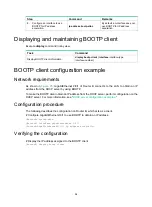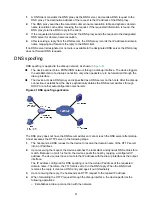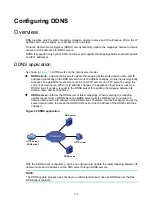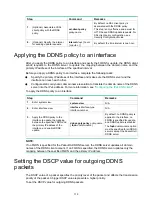
107
<Sysname> system-view
[Sysname] dns server 2.1.1.2
# Specify
com
as the name suffix.
[Sysname] dns domain com
Verifying the configuration
# Execute the
ping host
command on the device.
[Sysname] ping host
Ping host.com (3.1.1.1): 56 data bytes, press CTRL_C to break
56 bytes from 3.1.1.1: icmp_seq=0 ttl=255 time=1.000 ms
56 bytes from 3.1.1.1: icmp_seq=1 ttl=255 time=1.000 ms
56 bytes from 3.1.1.1: icmp_seq=2 ttl=255 time=1.000 ms
56 bytes from 3.1.1.1: icmp_seq=3 ttl=255 time=1.000 ms
56 bytes from 3.1.1.1: icmp_seq=4 ttl=255 time=2.000 ms
--- Ping statistics for host ---
5 packet(s) transmitted, 5 packet(s) received, 0.0% packet loss
round-trip min/avg/max/std-dev = 1.000/1.200/2.000/0.400 ms
The output shows that the communication between the device and the host is normal and that the
translated destination IP address is 3.1.1.1.
DNS proxy configuration example
Network requirements
When the IP address of the DNS server changes, you must configure the new IPv6 address of the
DNS server on each device on the LAN. To simplify network management, you can use the DNS
proxy function.
As shown in
:
•
Specify Device A as the DNS server of Device B (the DNS client). Device A acts as a DNS proxy.
The IPv6 address of the real DNS server is 4.1.1.1.
•
Configure the IP address of the DNS proxy on Device B. DNS requests of Device B are
forwarded to the real DNS server through the DNS proxy.
Figure 47 Network diagram
















































